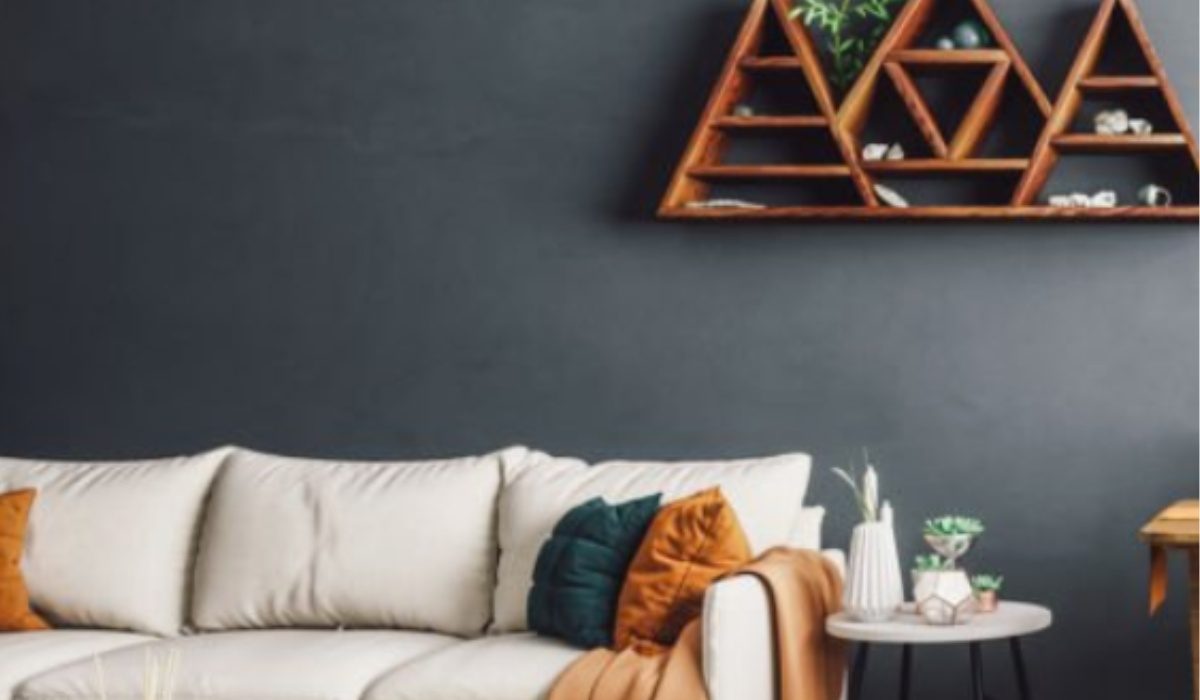A dark colour palette has a charm of its own in home decor. From gothic to opulent, you can achieve a wide range of aesthetics and themes using dark colours. However, despite their versatility, dark colours have their own set of perils as they can easily overwhelm the space and make it appear darker and more cramped than it actually is. In this article, we will discuss some things to keep in mind while using dark colours for rooms to make the most of your interior decor project.
See also: How do colours impact everyday spaces?
Lighting
Both natural and artificial lighting are equally important in influencing the overall ambiance of your room. Keep windows unobstructed and use light and airy treatments to maximise the amount of natural light entering the room. Dark coloured rooms are prone to shadows. Avoid this by layering the artificial lighting in a combination of overhead lights, floor lamps, table lamps and wall sconces. You can even consider installing dimmers to adjust the light levels.
Balance
Irrespective of the kind of home decor project you are undertaking, balance is key in achieving a visually pleasing space. Make sure to adequately counterbalance dark walls with lighter furniture, rugs and accessories. Pastel colours are highly recommended for this purpose. Use lighter colours for trim and mouldings to add contrast and easily make the walls pop without overwhelming the space.
Room size
Using dark colours is ideally recommended for larger rooms as they can make the expansive space feel cosier. However, if using them in a smaller room, consider an accent wall or using them in furniture and decor while keeping the walls neutral.
Texture and contrast
Introducing texture to your dark-themed rooms can help add depth. You can combine a matte wall finish with glossy furniture, velvet cushions and a shaggy rug. Contrasting elements are also a good way to add visual interest, such as metallic picture frames, bright artwork or colourful decor items.
Purpose and mood
In bedrooms, dark colours are preferred as they make them feel cosy and serene, creating a perfect restful atmosphere. While they add sophistication to living rooms, they should be balanced with lively decor to make the space feel inviting. If not balanced properly, dark colours can feel heavy and not have the desired effect.
Ceilings
Light ceilings are generally preferred by homeowners as they make the room feel taller and more open. Therefore, it is recommended to use soft white or pastel shades to keep the room feeling more airy. However, in rooms with high ceilings, using a dark colour results in a dramatic effect. To make sure that the ceiling does not become too oppressive, it is recommended to light the room well.
Colour undertones
If you wish to enhance the cosiness of the room, it is recommended to use colours like burgundy, charcoal or olive green. Conversely, shades with cool undertones like navy blue or deep teal can make the space more expansive and modern.
Reflective surfaces
A good way to make a dark-coloured room feel larger is by using large mirrors to reflect the light. Create a focal point using a statement mirror to add to the elegance of the space. If you don’t want a mirror, incorporating metallic finishes can have the same effect. Light fixtures, picture frames and other decor items with reflective surfaces can bounce light and enhance the brightness of the room.
Cohesive decor
Whatever colour scheme you choose for your room, make sure to keep it consistent throughout the space. Additionally, opt for decor that aligns with the overall aesthetic you are aiming for in a way that contributes to a cohesive look. Keep clutter at bay as they can further make the space feel cramped.
Maintenance
Dark walls are prone to highlight dust, fingerprints and smudges and require regular cleaning. Dust regularly with a soft, damp cloth and remove marks using a gentle cleaner. High-quality and durable paint finishes, such as matte and eggshell, can better withstand frequent cleaning and hide imperfections.
FAQs
Will dark colours make my room look smaller?
While dark colours can make the room feel more enclosed, this can be easily avoided by strategic lighting and balanced contrast.
How can I prevent a dark-coloured room from feeling gloomy?
Focus on creating a layered lighting, incorporating reflective surfaces and adding lighter-coloured accents and decor to brighten up the space.
What are the best dark colours to use in a room?
Consider colours like navy blue, charcoal grey, deep green, rich burgundy and black according to the kind of undertone you want.
Can I use dark colours in a small room?
When using dark colours in a small room, it is recommended to keep an accent dark wall and keep the other walls light and ensure good lighting.
How do dark colours affect the mood of a room?
While cooler dark shades evoke a sense of calm and serenity, rich, warm colours are ideal for a cosy, intimate setting. Black and charcoal can add sophistication and elegance.
What finishes are best for dark-coloured walls?
Matte and eggshell finishes are recommended for dark walls as they hide imperfections and are durable enough to withstand regular cleaning.
How can I integrate dark colours with existing decor?
Identify the key elements of your current design while choosing a colour scheme that complements the decor elements and accents of your space.
| Got any questions or point of view on our article? We would love to hear from you. Write to our Editor-in-Chief Jhumur Ghosh at jhumur.ghosh1@housing.com |







